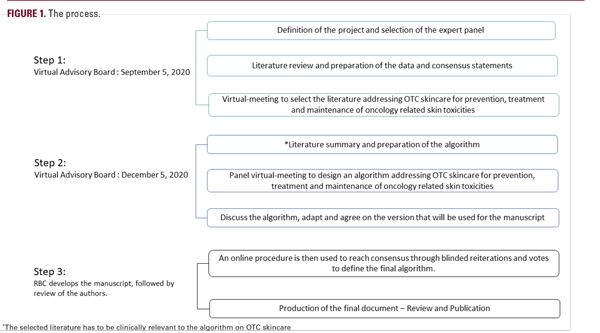treatment do not get medical attention needed to prevent their occurrence or provide early and effective treatment.8,9 As a result, cutaneous toxicities may be disabling or disfiguring, cause pruritus or pain, alter tactile exchange, impede interpersonal relationships, severely affect the quality of life,6,7 and may lead to reduction or discontinuation of anticancer treatment, affecting clinical outcomes.8-12
A preemptive skincare regimen has been shown to improve patients' quality of life and skin conditions.7,8 In a study of 95 patients receiving panitumumab-containing therapy, 48 received pre-emptive skincare and 47 received reactive. The incidence of severe skin toxicities in the pre-emptive skincare group had reduced by 50% compared to the reactive skincare group.7 Moreover, dermatology consultation has led to a reduced interruption of oncology treatment.9
A multidisciplinary oncology treatment team should educate on prevention, treatment, and maintenance using OTC skincare as part of their cancer patients' comprehensive care before cancer treatment starts.12 An algorithm was designed to reduce the incidence of cAEs, treat cAEs, and maintain healthy skin using general measures and OTC agents to support all healthcare providers treating oncology patients, including physicians, nurses, pharmacists, and advanced providers. The clinical algorithm would be feasible to implement by non-dermatologists. It aims to support clinicians working with oncology patients throughout the entire continuum of care to achieve optimal outcomes, improving patients' quality of life.
A preemptive skincare regimen has been shown to improve patients' quality of life and skin conditions.7,8 In a study of 95 patients receiving panitumumab-containing therapy, 48 received pre-emptive skincare and 47 received reactive. The incidence of severe skin toxicities in the pre-emptive skincare group had reduced by 50% compared to the reactive skincare group.7 Moreover, dermatology consultation has led to a reduced interruption of oncology treatment.9
A multidisciplinary oncology treatment team should educate on prevention, treatment, and maintenance using OTC skincare as part of their cancer patients' comprehensive care before cancer treatment starts.12 An algorithm was designed to reduce the incidence of cAEs, treat cAEs, and maintain healthy skin using general measures and OTC agents to support all healthcare providers treating oncology patients, including physicians, nurses, pharmacists, and advanced providers. The clinical algorithm would be feasible to implement by non-dermatologists. It aims to support clinicians working with oncology patients throughout the entire continuum of care to achieve optimal outcomes, improving patients' quality of life.
SCOPE
The US Cutaneous Oncodermatology Management (USCOM)
project initiated by La-Roche Posay aims to improve cancer
patients' and survivors' quality of life by offering tools
for preventing and managing cAEs. The USCOM panel of
clinicians who treat cAEs developed, discussed, and reached
a consensus on statements and an evidence-based algorithm.
The algorithm focuses on prevention measures and skincare
for cAEs using a skincare regimen, including hygiene,
moisturization, sun protection, and camouflage products.
The algorithm aims to improve patient outcomes and seeks
to determine the best approach for oncology skin care
programs for all stakeholders in the US health care setting.
These include medical oncologists, radiation oncologists,
family practice/internal medicine physicians, dermatologists,
oncology nurses, advanced practice providers (APPs),
nurse practitioners (NPs), physician assistants (PAs), and
pharmacists.
METHODS
For the statements and the USCOM algorithm's development, the panel used a modified Delphi approach following the AGREE II instrument.13,14 The modified Delphi method is a communication technique for interactive decision-making for medical projects.14 The method was adapted from face-toface meetings to a virtual meeting to discuss the outcome of








